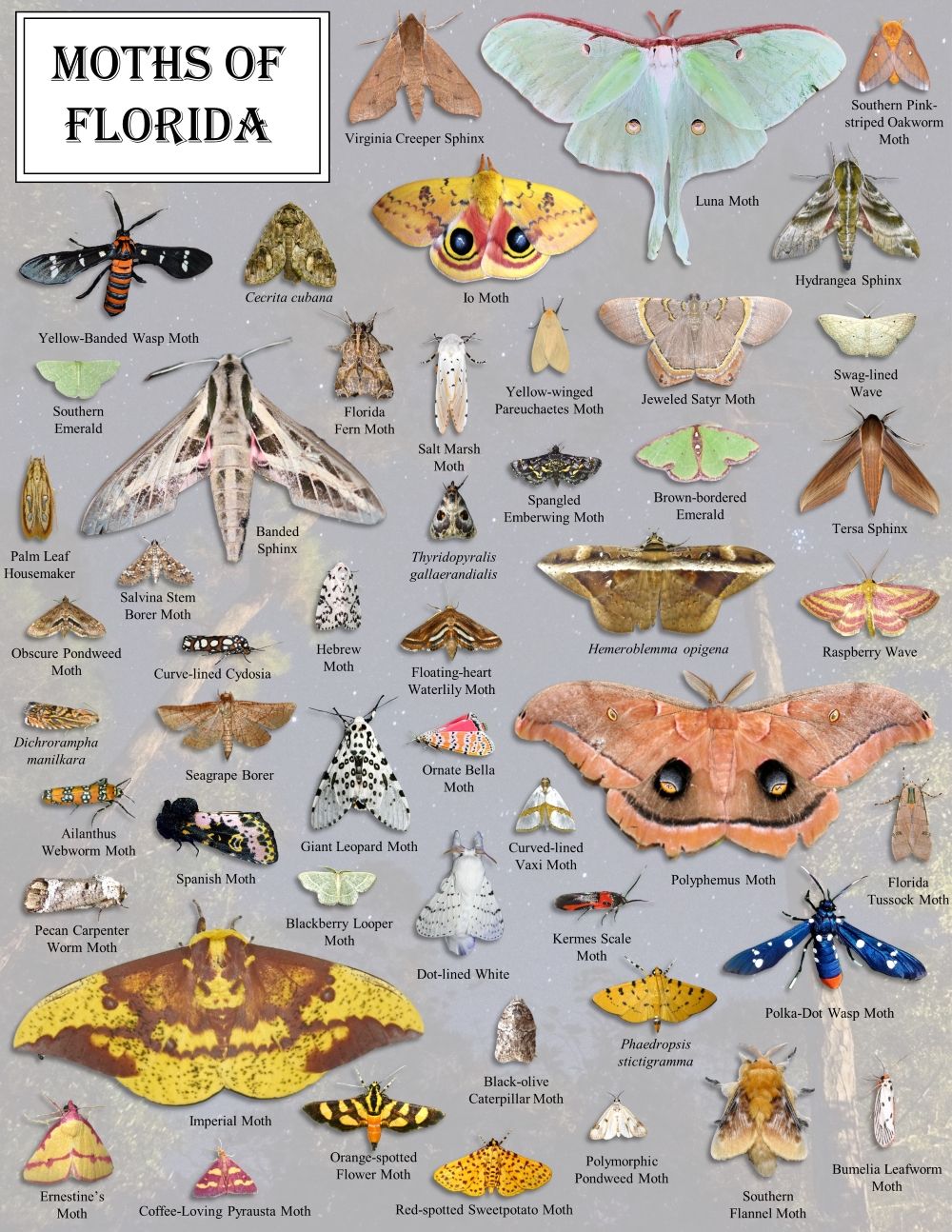An Introduction to the Wonderful World of Moths
Moths belong to the order Lepidoptera, encompassing a remarkable diversity with an array of shapes, sizes, and intricate wing patterns (Figure 1). Moths outnumber their well-known counterparts, butterflies, with over 10,000 species in North America alone (Pickering et al. 2016), compared to approximately 700 butterfly species (Scott 1992). Moths may be small, but they have a big ecological impact. They are essential pollinators and occupy vital positions in the food chain, serving as an important food source for many other living things. Moths thrive in various habitats worldwide, ranging from forests, wetlands, grasslands, and meadows to bustling urban areas. Because of their ubiquity, diversity, and the ease with which they can be observed, moths offer an excellent opportunity to engage with the natural world.
By documenting and identifying moths, we gain valuable insights into the biodiversity and health of ecosystems. Individual observations of moths help scientists track moth population trends, identify species at risk, and study the impacts of environmental changes on their populations. Furthermore, understanding moths contributes to our broader knowledge of insect biology and evolution, unraveling fascinating adaptations, behaviors, and ecological relationships. A single person can make meaningful contributions to science by documenting moths and sharing their observations on platforms like iNaturalist. Each observation becomes a valuable data point, collectively contributing to a better understanding of moths and the ecosystems they inhabit. By observing, photographing, and recording information about moths, anyone can participate in this scientific endeavor, playing a critical role in advancing our understanding of moths. The purpose of this publication is to provide guidance and tips on how to enter the wonderful world of moths, or “mothing,” and, further, how to leverage iNaturalist to document moth observations through citizen science. The intended audience is anyone who is interested in the natural world and wants to learn more about observing moths, identifying moths, and contributing to science by adding their observations to iNaturalist.
Using iNaturalist to Document and Identify Moths
iNaturalist (https://www.inaturalist.org/) is a citizen science platform that combines the wonders of nature with the collective efforts of a global community. iNaturalist is an independent multitaxa platform, allowing participants to contribute observations of any organism, or traces thereof, along with information about where and when that observation took place. The program is free to use and can be accessed via a user-friendly website and mobile app. The key to iNaturalist’s success lies in the precision and thoroughness of the contributed observations. Achieving an accurate identification for an observation can be a challenge, but each user can use their own experience and knowledge to type in their own identification. When posting an organism unknown to the user, the auto-ID suggestion, which provides a list of species that match the supplied photograph and location, can be a handy way to get the ball rolling in the quest to identify the observation. This suggestion is provided by a computer vision algorithm that is constantly improving, aided by the iNaturalist community of identifiers that correct and confirm identifications (the iNaturalist blog has more information in their blog post "Vision Model Updates"). By supplying accurate information about species and locations, the contributions become valuable data points that aid researchers, conservationists, and policymakers in understanding and safeguarding the natural world. For these reasons, iNaturalist offers an excellent tool to help you jump fully into the world of moths and mothing. For more information on iNaturalist, see https://www.inaturalist.org/pages/about, and see https://www.inaturalist.org/pages/getting+started for further details on how to get started. Some curated resources are available on Joe MDO's profile page. Your local UF/IFAS Extension office is a reliable resource for research-based information that can help you identify species. A directory of UF/IFAS Extension offices is available at https://directory.ifas.ufl.edu/.
As of 2023, of the approximately 160,000 species of moths in the world, 48,110 have been submitted to iNaturalist. In the United States, 9,389 moth species have been submitted to iNaturalist with the most commonly reported moths being white-lined sphinx, Isabella tiger moth, Polyphemus moth, North American luna moth, ailanthus webworm moth, salt marsh moth, fall webworm moth, giant leopard moth, green cloverworm moth, and eastern tent caterpillar moth (Figure 2). In Florida, 1,960 moth species have been submitted to iNaturalist with the most commonly reported moths being fir tussock moth, Io moth, Polyphemus moth, polka-dot wasp moth, southern pink-striped oakworm moth, tersa sphinx, ornate bella moth, salt marsh moth, giant leopard moth, and orange-spotted flower moth (Figure 2).
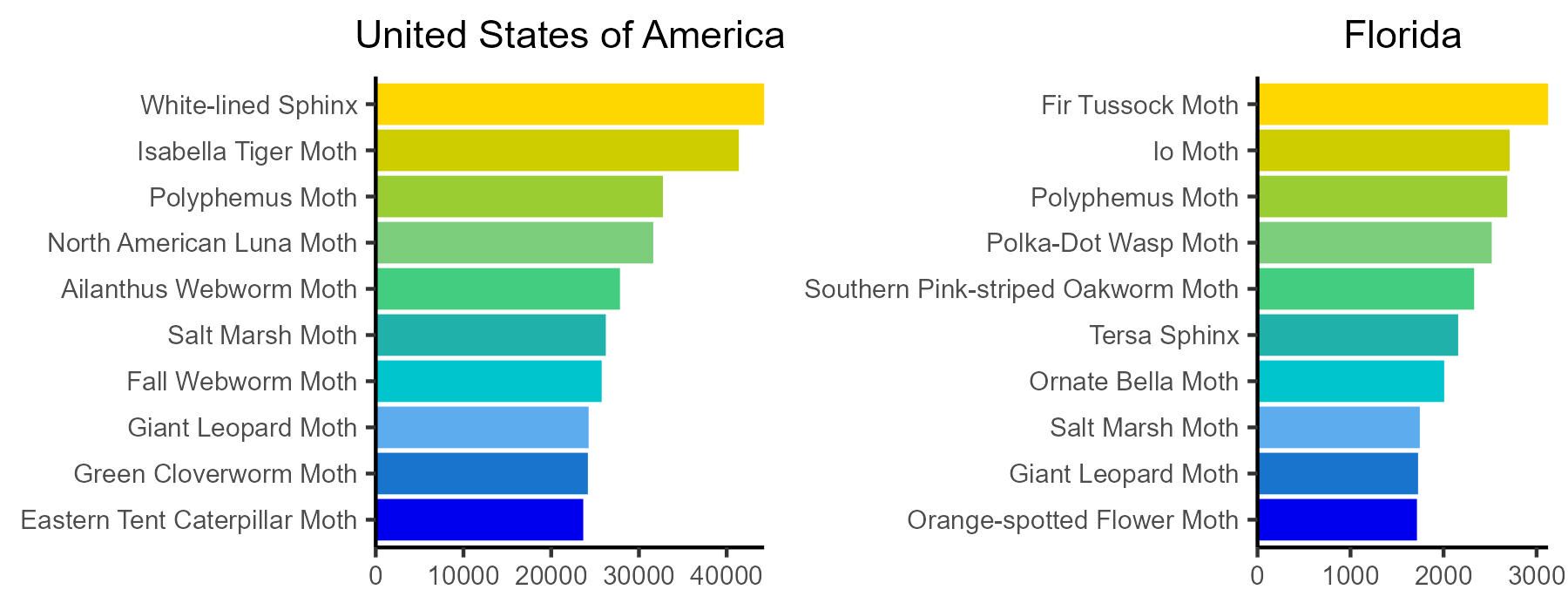
Credit: Produced from iNaturalist data
Attracting and Observing Moths
Moths are generally nocturnal, although some species fly during the day, and are referred to as “day fliers.” Here, we largely focus on nocturnal moths. At northern latitudes, moths are most active during the summer months and on warm nights (Jonason, Franzén, and Ranius 2014), whereas in Florida and other regions of the United States, such as lower elevations of the Southwest, the peak season can be from approximately February to May, with an additional peak of activity in the fall months. Keep in mind, however, that different moths have different flight periods, so to maximize the diversity of moths you see, it is best to go mothing throughout the year. See Figure 3 to learn good strategies for finding and observing moths. There are two main methods for attracting a wide array of moths, each of which will attract different species. The first involves artificial lights, and the second involves homemade sugar baits.
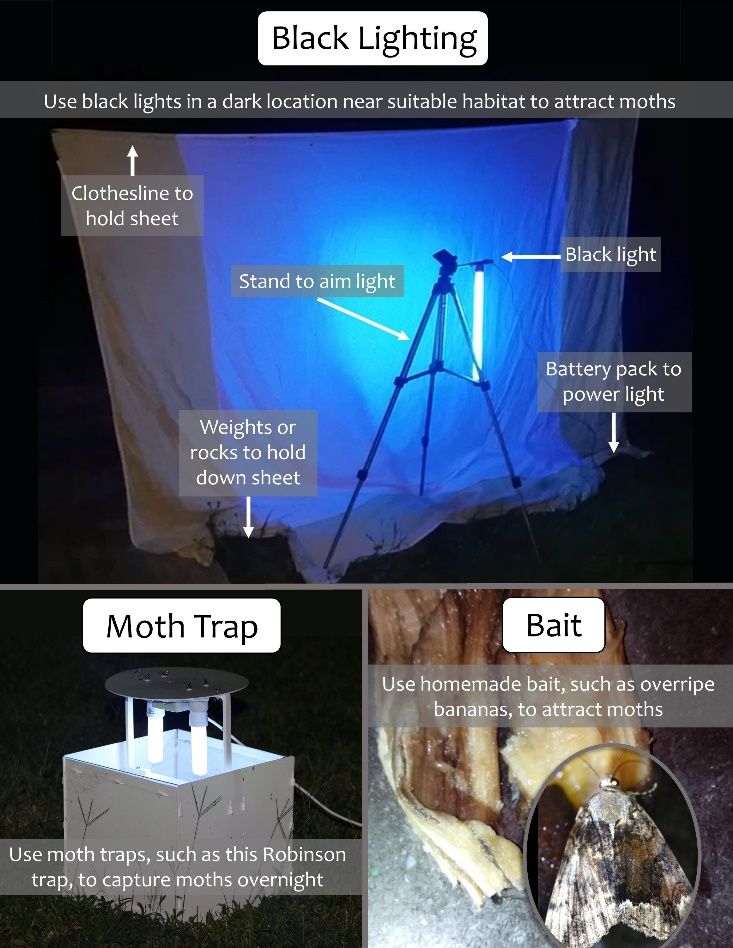
Credit: Joe Montes de Oca and Corey Callaghan, UF/IFAS
Lights
Moths and many other flying insects are attracted to light. The easiest way to begin observing moths is to check lights after dark. Even leaving your porch light on for a few hours after the sun sets and checking every hour or so for new visitors can be rewarding and produce a multitude of species.
For better results, try a black light. Black lights are special bulbs that emit ultraviolet light, specifically in the UVA range (wavelengths between 315 and 400 nanometers, or nm) (Wang et al. 2019). One way to use a black light is to hang a white sheet over a clothesline or between trees and strategically illuminate it with a light source. There are many affordable and portable black lights available online, usually in LED format. These are often advertised as DJ equipment or party supplies, or sometimes pet-stain detectors. For portability, lights that have USB cords are particularly useful because they can be plugged into the same USB battery packs that are used to recharge smartphones. Check your USB battery pack’s milliamp hours (mAh) to better understand its capacity. A typical 10,000 mAh battery pack, for example, can power a 10-watt UV LED black light for about three hours. The light can be aimed at the sheet from one or two feet away on a tripod or stand (like a guitar stand), hung from another clothesline or rope between trees, hung on the sheet itself, or even propped up at an angle from the ground to direct the light out into the night. Multiple lights at different angles can be advantageous as well. The light will attract moths, drawing them to the sheet where you can most easily observe and photograph them. For the most favorable outcome, select a night with minimal moonlight and find a dark location that will allow your lights to shine their brightest without competing with other sources of lighting like streetlamps. Experiment with regular bulbs, black lights, or the more powerful mercury vapor lights. Different lights attract a greater variety of moth species. Also bear in mind that some moth species may be more attracted to specific habitats or plant species. Vary placement of the black light to increase the chance that you attract a variety of moths. Often, orienting your light/sheet towards a large open space, such as a prairie or meadow, especially one at the edge of another habitat, such as a forest or cypress swamp, yields the largest diversity of moths.
In addition to sheets, moth “traps” can be used to attract moths. There are different types of traps (butterfly-conservation.org has a handy pdf here with examples), but they are all designed specifically to attract moths and temporarily “catch” them overnight. It is best to set up the moth trap at dusk and then check it in the morning. Use empty cardboard egg cartons or something similarly textured. Moths have trouble perching on slick surfaces; they will be more likely to remain in your trap until the morning for you to see them if you provide them a comfortable place to rest. After you’ve had a chance to enjoy your moth visitors, dismantle your moth-attracting apparatus and let the moths return to their normal activities. Whether you choose to use a sheet or moth trap, the most important thing to remember is to release the moths when you’re finished documenting your observations.
Bait
Not all moth species are attracted to lights. To entice species that rarely visit lights, you can try a technique known as “sugaring” using a homemade bait. Numerous bait recipes you can find online offer various options. A common mixture includes overripe bananas, brown sugar, molasses, and a touch of beer. Blend these ingredients into a spreadable consistency that is neither too thin (prone to runoff) or too thick to spread. While allowing the concoction to ferment for a few days can enhance its allure, it is not obligatory. Apply the bait generously onto a tree trunk, positioning it at eye level. Aim for a reasonably large patch, typically around one square foot, although exact dimensions are not important—moths don’t care! Return every half hour to an hour to observe and photograph any moths indulging in your sugary feast. Note that some moths will sometimes only visit briefly, and thus checking on the bait more often may yield more glimpses of a greater variety of species. In a pinch, an overripe banana can also simply be opened and placed on a flat surface. After opening the banana, place the peels with the inside facing up in 2–4 different locations. See figure 3 for an example of a banana peel being visited by a moth.
Best Practices for Taking Photos of Moths for Identification
Many factors come into play when photographing and identifying moths. Thankfully, most described moth species, especially larger species (over 1cm) are quite distinct and can often even be identified with just a single photo. If you can, though, try to capture photos from two or more angles. The angles you aim for may depend on the individual moth since species come in many shapes and hold their wings in different ways. Close-up shots of wing patterns, coloration, and any unique markings or features can aid in distinguishing between species. To identify and classify moth observations accurately, first capture clear images of the moth’s wings. Be sure to highlight the intricate patterns and coloration. Pay attention to details such as the shape of the wings, presence of specific markings or lines, and any unique features like wing fringe or distinctive antennae shape. Comparing the observed features with available resources, such as field guides or online databases, can help in narrowing down potential species. See Figure 4 for an example of a moth best photographed from a lateral angle rather than a typical dorsal angle, as well as for an illustration of the importance of cropping a photo for identification.
Although most described moth species present a straightforward identification process as long as your images are of good quality, it is important to note that some moth species are extremely similar. These species often require expert in-hand examination for identification, sometimes even requiring dissection of the moth’s genitalia for confirmation.
When it comes to cameras, mothing newcomers often use smartphones. Smartphone cameras work quite well for larger moths when there is appropriate lighting. The phone’s flash or, even better, the beam from a small flashlight held in your other hand, will usually allow your phone’s auto-focus to capture a sharp image and should light the moth sufficiently for you to take a good photo. For smaller moths, however, a clip-on macro lens can be helpful for getting the moth in focus and capturing the detail necessary for an identification. Point-and-shoot cameras with macro-options can help improve image quality, but a DSLR or mirrorless camera with a macro lens and an external flash and flash diffuser will provide the highest quality images. Whether you use a smartphone or a specialized macro lens on a digital camera, an important step new moth hunters often overlook is image cropping. Because iNaturalist uses computer vision to generate ID suggestions, cropping is important. A tight crop of your moth can help filter out any distractions and will lead to a more accurate automated ID. Furthermore, cropped images are more likely to get the attention of an iNaturalist user who reviews moth observations. Help your observations stand out with higher-quality images that show more of the moth and less of the background. In addition to cropping your images, orient the photo so that the moth’s head is either directly at the top of the image or to the left or right. Correctly orienting your photos will facilitate comparisons between your images and those found in field guides and in online databases. It can be tricky framing the moth because they don’t always land head-up on the sheet. Fortunately, many photo editing programs allow images to be rotated by single degrees rather than by 90 degrees, allowing images to be corrected. See Figure 4 for an example.
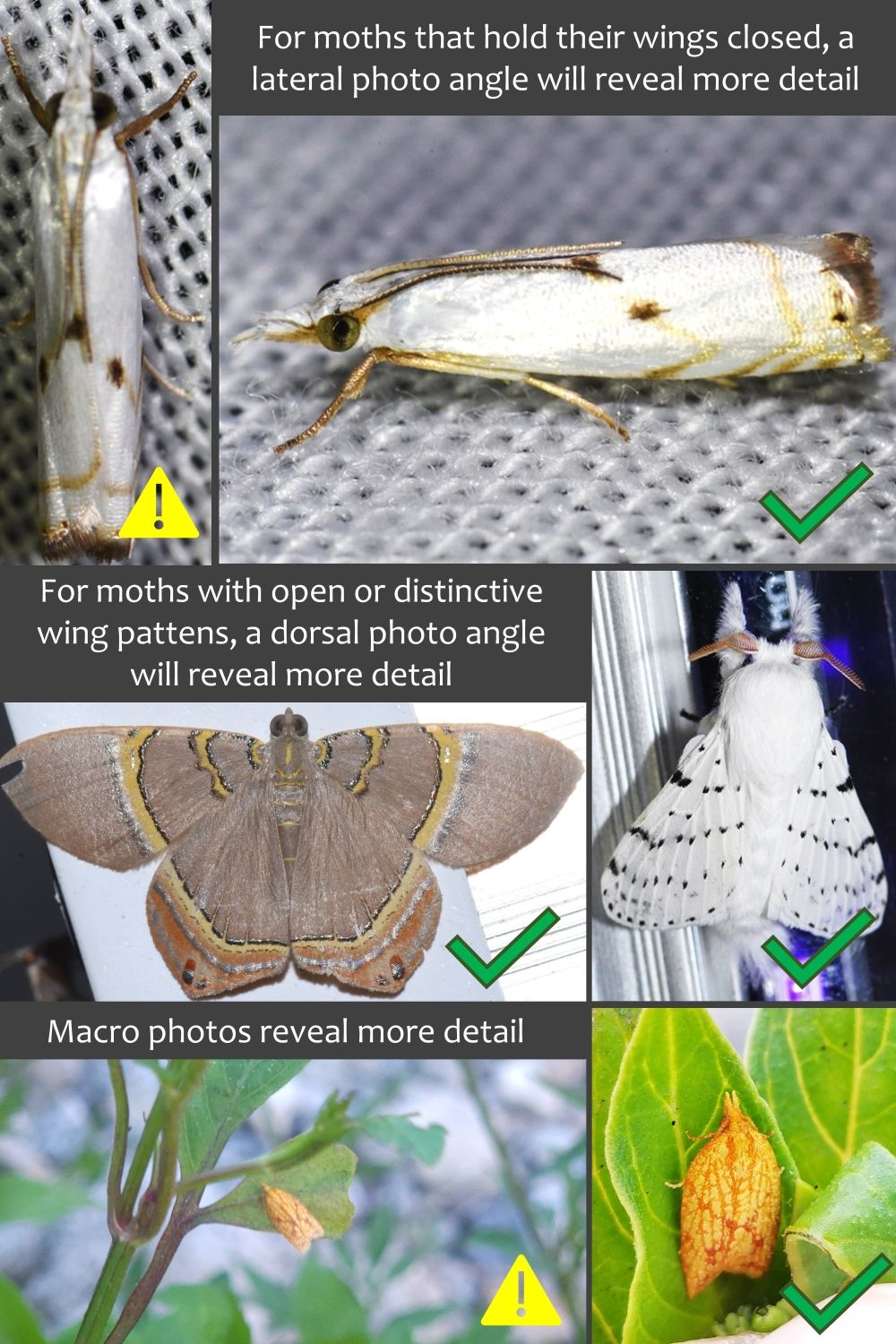
Credit: Joe Montes de Oca and Brittany Mason (bottom, left photo), UF/IFAS
A Deeper Dive on Using iNaturalist to Understand the World of Moths Near You
The iNaturalist website is an excellent resource to use to explore moth observations worldwide. The best way to explore moth species on iNaturalist is through the “Moths of the world!” project via the Explore tab. This page features an interactive map that can be filtered by location and moth species (Figure 5).
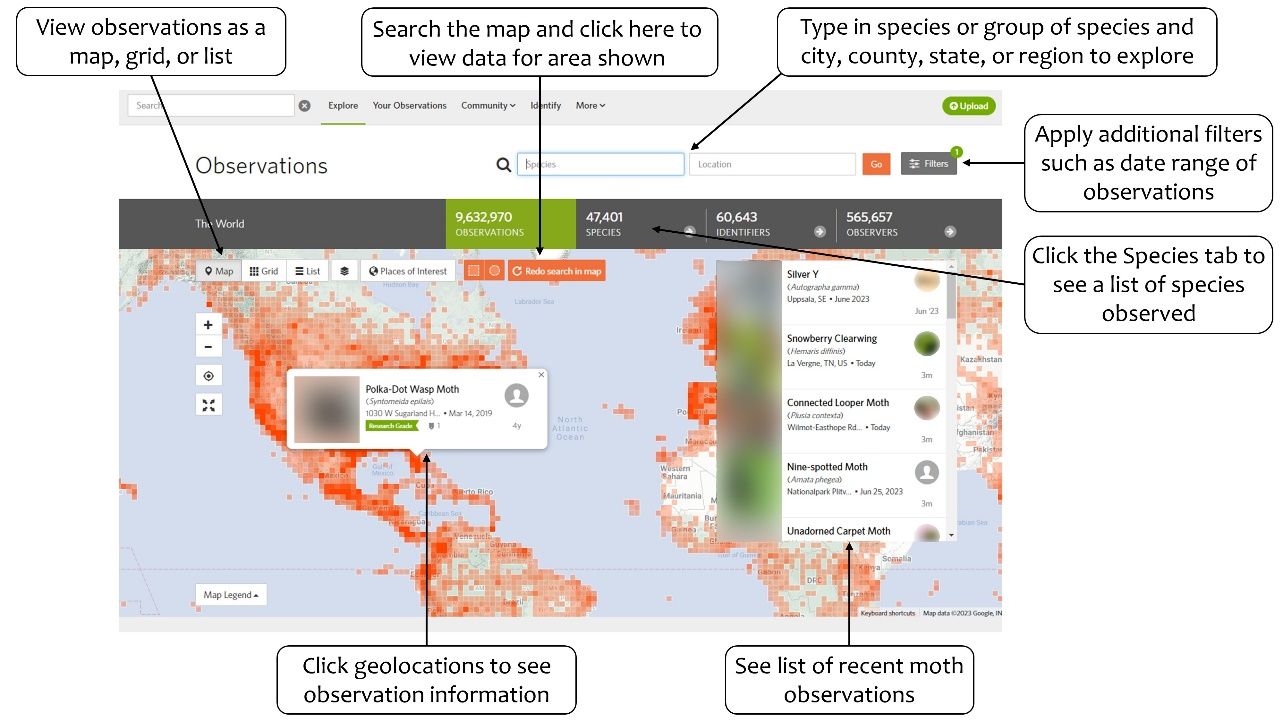
Credit:
Filter the interactive map to your city using the location box. Go to the “Species” tab next to “Observations” from the Explore page to see a list of moth species from your city (Figure 6). The species are arranged from most observed to least observed; the arrangement provides a general idea of which species are most common, although some biases may exist in the data. Learn more about each species by clicking on its entry. This will direct you to the information page for that species. The species information page contains a graph displaying what time of year the species is most likely to be observed and general information on the species from Wikipedia. The “Map” tab on this page displays an interactive map showing where this species has been observed.
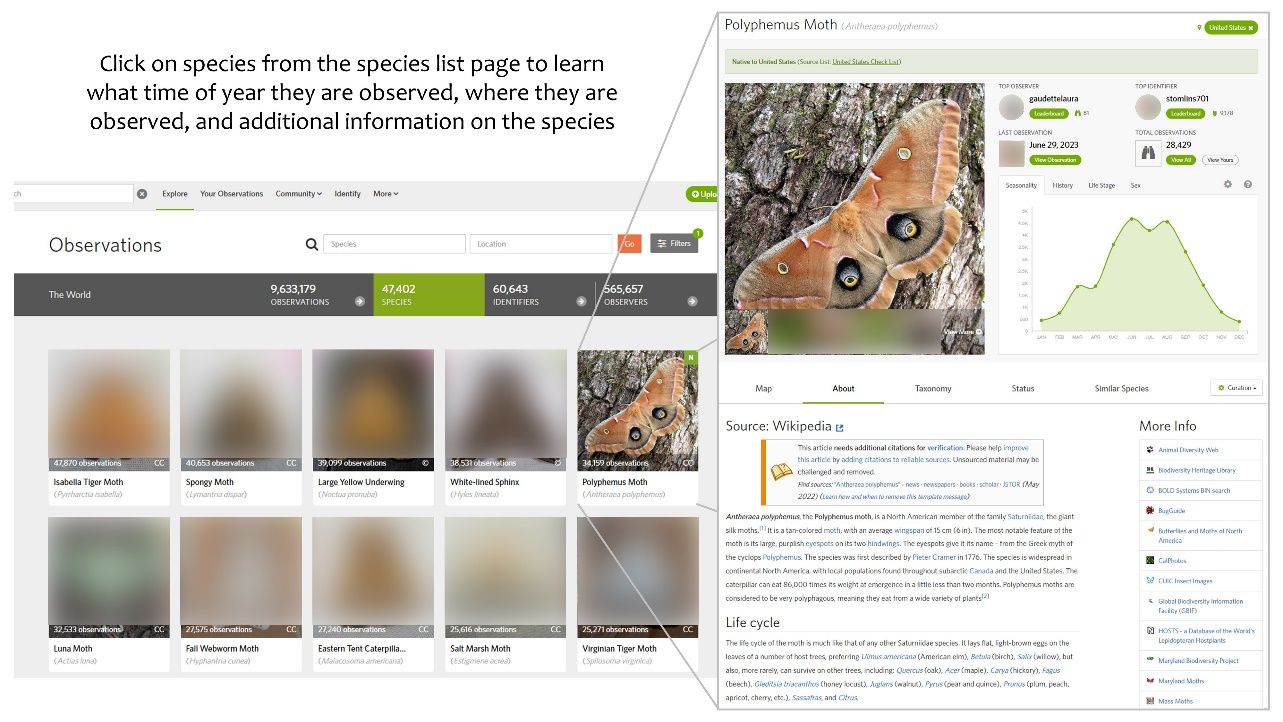
Credit: Website screenshots from www.iNaturalist.org and polyphemus moth photo by iNaturalist user Sean McCann (CC BY-NC-SA)
Once you are familiar with moth identification, consider helping others identify their moth observations from the “Identify” page. This page provides a grid view of observations and can be filtered as described above for the “Explore” page (see the getting started page for more information). Helping with identification is a great way to engage in the iNaturalist community and learn more about the moth species in your area. Additionally, identifications increase the value of observations for scientific use (see Callaghan et al. 2022 to learn more).
Conclusion
Moths are amazing creatures with nearly endless diversity. The great variety of moths provides observational opportunities to capture any nature enthusiast’s interest. It is important to prioritize the well-being of wildlife and wildlife habitats and to follow local regulations while documenting nature. Respect the natural behaviors of animals and maintain a safe distance during observations to avoid disturbance. Be mindful of the sensitivity of habitats and ecosystems, refraining from damaging habitat or collecting specimens without proper permits. Compliance with local regulations ensures the preservation of biodiversity and sustainable enjoyment of nature. In summary, this publication covered attracting and observing moths, emphasizing the importance of accurate observations. It provided insights into moth characteristics to bear in mind, considerations when documenting moths, valuable information to capture in descriptive photos, and guidelines for accurate identification. Let’s continue documenting and exploring biodiversity responsibly through iNaturalist to contribute to our understanding of the natural world.
Additional Resources
The North American Moth Photographers Group at the Mississippi Entomological Museum and Mississippi State University provides many photos of moths.
Butterfly Conservation’s website includes an in-depth moth trapping guide and a simplified kid-friendly guide here.
National moth week is an annual event celebrating the beauty of moths.
More details on baiting for moths from the national moth week association.
BugGuide is an online resource with photos of most moth species.
Don’t forget traditional field guides like The Peterson Field Guide to Moths of Southeastern North America.
References
Callaghan, Corey T., Thomas Mesaglio, John S. Ascher, Thomas M. Brooks, Analyn A. Cabras, Mark Chandler, William K. Cornwell, et al. 2022. “The Benefits of Contributing to the Citizen Science Platform iNaturalist as an Identifier.” PLoS Biology 20 (11): e3001843. https://doi.org/10.1371/journal.pbio.3001843
Jonason, Dennis, Markus Franzén, and Thomas Ranius. 2014. “Surveying Moths Using Light Traps: Effects of Weather and Time of Year.” PloS One 9 (3): e92453. https://doi.org/10.1371/journal.pone.0092453
Wang, Wenlong, Chenglong Gao, Lili Ren, and Youqing Luo. 2019. “The Effect of Longwave Ultraviolet Light Radiation on Dendrolimus Tabulaeformis Antioxidant and Detoxifying Enzymes.” Insects 11 (1): 1. https://doi.org/10.3390/insects11010001
